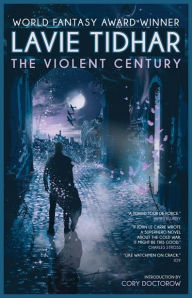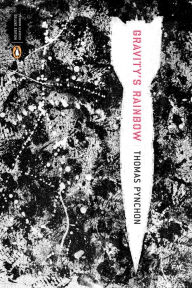In The Violent Century, Lavie Tidhar Turns Superheroes Inside-Out
 Michael Chabon’s Pulitzer-winning novel The Amazing Adventures of Kavalier & Clay tells a fictionalized account of the partnership between Jerry Siegel and Joe Shuster, the duo behind the first popular superhero, Superman. (Or maybe it’s an adjacent fiction? Superman’s creators exist in the novel, but the titular writing team are from the same milieu.) The novel shares themes with the subject matter: the children of Jewish immigrants to America invent a hero who fights for truth, justice, and the American way, all against a backdrop of the rising tide of fascism. Their hero, the Escapist, trades in Superman’s bulletproof invincibility for a slippery escapism; the leads, like Siegel and Shuster, are similarly exploited by their publishers. It’s a reboot, in a way, retelling the origin story of the original origin story.
Michael Chabon’s Pulitzer-winning novel The Amazing Adventures of Kavalier & Clay tells a fictionalized account of the partnership between Jerry Siegel and Joe Shuster, the duo behind the first popular superhero, Superman. (Or maybe it’s an adjacent fiction? Superman’s creators exist in the novel, but the titular writing team are from the same milieu.) The novel shares themes with the subject matter: the children of Jewish immigrants to America invent a hero who fights for truth, justice, and the American way, all against a backdrop of the rising tide of fascism. Their hero, the Escapist, trades in Superman’s bulletproof invincibility for a slippery escapism; the leads, like Siegel and Shuster, are similarly exploited by their publishers. It’s a reboot, in a way, retelling the origin story of the original origin story.
The Violent Century
The Violent Century
By Lavie Tidhar
In Stock Online
Paperback $16.95
Lavie Tidhar’s novel The Violent Century, originally published in 2015 and for the first time widely available in print in the U.S., reboots the origin stories of superheroes in a similar manner, though closer to secret or alternate history; he takes heroes we conjure or impress into service for the good of the nation off the page and layers them over our rough history.
Lavie Tidhar’s novel The Violent Century, originally published in 2015 and for the first time widely available in print in the U.S., reboots the origin stories of superheroes in a similar manner, though closer to secret or alternate history; he takes heroes we conjure or impress into service for the good of the nation off the page and layers them over our rough history.
The Violent Century‘s twist on the story of the Übermenschen is told lappingly, moving forward and backward through time. It opens with a man called Oblivion delivering a message to someone named Fogg: The Old Man wants to speak to you about what happened in 1946. The narrative then skips back to the mid-1930s, when the Old Man first plucked Fogg out of university due to his uncanny ability to control mist in the air, and installed him at The Farm—a sort of Bletchley Park for the changed, as those gifted with superhuman powers are also called, complete with a young Alan Turing.
There, Fogg meets others of the English changed: Tank, Mrs. Tinkle, Mr. Blur, and most importantly, Oblivion, who ends up being his constant companion through the second world war. The novel operates both as a spy novel and a novel of war as Fogg recounts his actions to the Old Man (and the ever watchful Oblivion) pushing through WWII, Vietnam, and 9/11, circling ever closer to those post-war events in Berlin that demand an accounting.
The Amazing Adventures of Kavalier and Clay (Pulitzer Prize Winner)
The Amazing Adventures of Kavalier and Clay (Pulitzer Prize Winner)
In Stock Online
Paperback
$17.99
$20.00
Though this is an alternate history—the changed inevitably participate in conflicts all over the globe—the introduction of the superhuman doesn’t materially change world history. The Old Man likens this to a nullification effect: the changed cancel each other out, existing, as they do, in a distributed manner within every country. Oblivion and Fogg go to Minsk and lose a member to the Nazi Wolfman whose ability renders the powers of others useless. They go to Leningrad, under German siege, and meet their Soviet counterparts in the Red Sickle and Rusalka. In 1964, Israel puts Dr. Volmacht, the Nazi scientist responsible for the changed, on trial, an affair modeled on Adolf Eichmann’s—famously recounted by Hannah Arendt in Eichmann in Jerusalem, in which she coined the term “the banality of evil.” Stanley Martin Lieber—who in this timeline wrote under the name Stan Lee—speaks at the trial in his capacity as a historian. Tidhar folds up history, translating fiction into reality and back, presenting it to the reader like a closely guarded secret.
Though this is an alternate history—the changed inevitably participate in conflicts all over the globe—the introduction of the superhuman doesn’t materially change world history. The Old Man likens this to a nullification effect: the changed cancel each other out, existing, as they do, in a distributed manner within every country. Oblivion and Fogg go to Minsk and lose a member to the Nazi Wolfman whose ability renders the powers of others useless. They go to Leningrad, under German siege, and meet their Soviet counterparts in the Red Sickle and Rusalka. In 1964, Israel puts Dr. Volmacht, the Nazi scientist responsible for the changed, on trial, an affair modeled on Adolf Eichmann’s—famously recounted by Hannah Arendt in Eichmann in Jerusalem, in which she coined the term “the banality of evil.” Stanley Martin Lieber—who in this timeline wrote under the name Stan Lee—speaks at the trial in his capacity as a historian. Tidhar folds up history, translating fiction into reality and back, presenting it to the reader like a closely guarded secret.
There’s something sly about the various powers attributed to the Übermenschen, the way their national identities are often expressed in almost laughable caricature. Fogg is from London (or thereabouts); he controls fog (what an appropriate name, then). The American changed—the Tigerman! The Electric Twins! The Green Gunman! (who, Fogg thinks sourly, isn’t even green) —they wear loud costumes and pose, enacting a performative propaganda. The Nazi changed are at turns terrifying or bathetic; the Soviets tragic and melancholic. That one of the British changed is called Oblivion—who can simply vanish things from tanks to people—is a pretty serious statement on the English national identity, especially in the age of Brexit. From one vantage, the Übermenschen seem comic, ridiculous: they are people wearing their underpants on the outside of their clothes. They feel like a national identity turned personal—or the maybe the other way around—both larger than life and inconsequentially small. They turn heroism inside out.
Though the events are often naturalistic and historical—everything from Auschwitz to the Soviet invasion of Afghanistan is accounted for—the introduction of the changed into the proceedings alters history in subtle ways. The changed ironically don’t change on the outside: trapped at the age they were when Dr. Vomacht activated his device in 1932 (the same year Siegel and Shuster created Superman). But as avatars of national identity, their roles in the conflicts that punctuate our history twist and mutate: Oblivion ends up in Vietnam while the U.S. was illegally bombing Laos and Cambodia during the war, working with the American Tigerman to find the former Nazi Wolfman who allied with the Russians and the Viet Cong, and whom they now want dead. Allegiances and alliances become murky. It was never as simple as donning a cape for one’s country, but eventually even the pretense vanishes. By the time Osama bin Laden arrives on the scene, the changed seem both irrelevant and exhausted.
Gravity's Rainbow
Gravity's Rainbow
By
Thomas Pynchon
Illustrator
Frank Miller
In Stock Online
Paperback $24.00
The Violent Century ruminates on the concept of the superhero—a term which never appears in the novel—by pondering the question of heroism itself. It seems fitting, in an odd way, that the reprint should coincide with the 50th anniversary of the moon landing: one of the heroes of the American space program, Wernher von Braun (who cameos here), was a good looking man with a matinee idol’s jaw. During the second world war, von Braun was a member of the Nazi party and the SS, and a German war hero for designing the V-2 rocket. (Thomas Pynchon’s postmodernist classic Gravity’s Rainbow opens with the V-2 screaming across the sky.) He was repatriated to the United States along with dozens of Nazi scientists—and, in The Violent Century, with German Übermenschen—through Operation Paperclip, his history whitewashed for his scientific abilities. The concept of the hero implies a service to the state; when the state changes, heroism inevitably changes too.
The Violent Century ruminates on the concept of the superhero—a term which never appears in the novel—by pondering the question of heroism itself. It seems fitting, in an odd way, that the reprint should coincide with the 50th anniversary of the moon landing: one of the heroes of the American space program, Wernher von Braun (who cameos here), was a good looking man with a matinee idol’s jaw. During the second world war, von Braun was a member of the Nazi party and the SS, and a German war hero for designing the V-2 rocket. (Thomas Pynchon’s postmodernist classic Gravity’s Rainbow opens with the V-2 screaming across the sky.) He was repatriated to the United States along with dozens of Nazi scientists—and, in The Violent Century, with German Übermenschen—through Operation Paperclip, his history whitewashed for his scientific abilities. The concept of the hero implies a service to the state; when the state changes, heroism inevitably changes too.
Though The Violent Century is never particularly emotionally engaging—Tidhar’s typically choppy style and rapid scene shifts preclude an emotional immersion—it is a brilliant novel of ideas.


